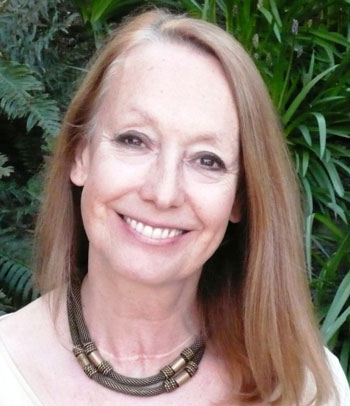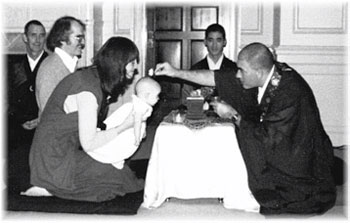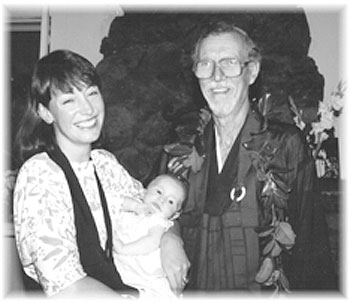
Erica Rayner-Horn.

Parent Profile: Erica Rayner-Horn
Erica Rayner-Horn, M.A. is the mother of two adult children. A Buddhist practitioner for more three decades, she has trained in both Zen and Tibetan traditions. She is a psychotherapist in Seattle and one of the coordinators of the upcoming Family Dharma Conference, where she will speak on Buddhist parenting.
My interest in Buddhism began more than 30 years ago when I read two books on Zen and was so impressed and astounded that I left England on a one-way ticket to Japan to train in a Rinzai Zen temple. After three years of rigorous training and practice, I married a fellow student and came to the United States, settling first in the Catskills in New York State.
I became a student of Bernie Glassman Roshi and was preparing for my Jukai (lay-Buddhist vows) when my daughter was born. One of the first dilemmas I encountered as a parent and Buddhist practitioner was how to give our child the equivalent of a christening in the Buddhist tradition. Together with Glassman Roshi and Peter Matthiessen, we concocted a very beautiful ceremony that concluded with Roshi sprinkling water from a flower onto my daughter’s head, accompanied by various gathas. It was quite beautiful and we were more than satisfied. The little gilt Jizo figure that Roshi gave her is still sitting on her altar.

Glassman Roshi conducting Blessing Ceremony for the first child of the family, upstate New York.
Four years later when my son was born, we were living in Hawaii and were members of Robert Aitken Roshi’s Diamond Sangha. My son was very ill in his first couple of months and his Blessing Ceremony was attended by the whole Sangha, including many children. This time we chose the equivalent of godparents who were present at the ceremony. Everyone wore flower leis and made offerings of incense and flowers. It was a lovely ceremony that the whole Sangha enjoyed.
Many of our friends and fellow practitioners at Diamond Sangha were also parents of young children so together we created programs for them. Thich Nhat Hahn came to give us teachings and lead us all in mindfulness practices and rituals. I still have a vivid memory of walking meditation with him, as we walked slowly and mindfully around the carpeted Dharma Hall of Koko An (which was the living room of a suburban house) whispering the mantra “Walking the Green Earth!”. Several of us took our families to Thay’s Family Retreats where we learned more about how to integrate Dharma in everyday family life. Various annual events evolved, such as Buddha”s birthday, in which the children poured tea over the baby Buddha figure and surrounded him with flowers and little offerings.

In Hawaii, Robert Aitken Roshi performed a Blessing Ceremony for the family’s second child.
On moving to the Northwest, we found ourselves without a family-supporting sangha, in fact without a sangha at all. We continued with some of the practices we had shared with the Diamond Sangha in Honolulu and invented some of our own.
For example, I encouraged the children to create their own altars next to the main altar in our shrine room. They did so, placing on them an array of objects that were meaningful to them. To this day, my children’s altars still bear the collar of a deceased family dog, a knight in armor, a picture of Princess Di, various beeswax figures they made at the Waldorf School, as well as the more conventional Buddha figures and malas!
We also created a bedtime prayer ritual that combined the elements of different traditions. The children lit candles on the altar, offered incense, and then each family member spoke of whatever they pleased, loosely termed prayers. This was an interesting opportunity to offer thoughts and prayers for others, but also sometimes to apologize for a fight or wrongdoing or to speak about a struggle someone was having, and ask for help.
My son’s favorite ritual was the Mindfulness Bell. It sat on the dining table and anyone could strike it at any time. This was followed by silence and a few minutes of returning to our breathing–as Thay had taught us. However, my son quickly discovered this was also useful for ending tedious conversations or ones in which he was in trouble!
My children have now both graduated from college. The ways that we integrated Buddhist practice into our family life, I feel, were a helpful addition to their upbringing. I encourage parents to learn more about how different sanghas involve children and families in their practice, but also to be creative and invent rituals and practices of their own. In this way the unique cultural history and personalities of different family members can be incorporated.
Information about the Family Dharma Conference is available at www.northwestdharma.org.
Contributor: Erica Rayner-Horn.
Photos: Courtesy of Erica Rayner-Horn.